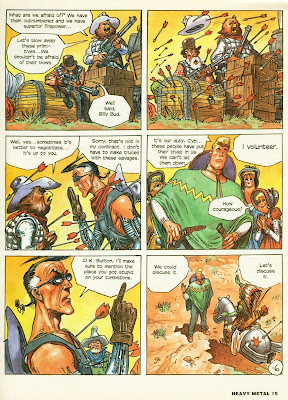Sunday, January 16, 2022
R.I.P. Ron Goulart, 1933- 2022
Friday, January 14, 2022
Book Review: The Swords of Corum
Wednesday, January 12, 2022
Bud Plant's Incredible Catalog
The catalog from Bud Plant arrived recently, and I thought I am overdue to promote it here at the PorPor Books Blog.
Bud Plant began his career in 1968 when he partnered with five friends to establish a San Jose, California comic book store called 'Seven Sons Comic Shop'. In the 1980s Plant became the major distributor of comics along the west coast, and began selling comics and books and related materials through his own mail-order company.
In the days before the internet, if you were a fan of comics and associated media, Bud Plant was one of the few places where you could find such stuff, and receiving the Bud Plant's Incredible Catalog always was cause for due consideration. I began patronizing the Incredible Catalog back in the late 1980s / early 1990s, and I've stayed with it since.
The prices in the Incredible Catalog are competitive with those of amazon, particularly nowadays when more and more bookjackers, dropshippers, and speculators are allowed to sell at amazon despite having approval ratings below the recommended minimum of 93%.
Monday, January 10, 2022
Michael Fishel: Creations
Creations
I finished 'Creations' thinking that, short of obtaining puzzles (which are 30 x 24 inches) and posters of the depicted artwork, there really is no current form of image reproduction that will allow the viewer to fully take in the totality of Fishel's works. That said, if a publisher like Titan Books, or Taschen, or Fantagraphics, should elect to issue a large-size book of Fishel's paintings, that would be wonderful.
Friday, January 7, 2022
Burton and Cyb: The Conquest of the West
Tuesday, January 4, 2022
Book Review: 'Tracer' by Stuart Jackson
Sunday, January 2, 2022
Friday, December 31, 2021
Alien Legion: Slaughterworld
Tuesday, December 28, 2021
Christmas 2021 antique store finds
Friday, December 24, 2021
Book Review: Deadhead
According to Grady Hendrix's 2017 book Paperbacks from Hell: The Twisted History of ‘70s and ‘80s Horror Fiction, the runaway success of Thomas Harris's 1988 novel The Silence of the Lambs turned paperback publishers away from printing horror titles and towards printing serial killer novels. The horror paperback boom of the 1980s dwindled, with Dell's 'Abyss' line of weird horror / psychological horror novels bravely waving the banner before closing up shop in 1995.
So perhaps that's why the UK's most prominent splatterpunk horror writer, Shaun Hutson, decided to venture into the serial killer genre with his 1993 novel 'Deadhead' (326 pp.).
'Deadhead' is set in London in the early 1990s. Hutson takes pains to depict this summertime London as a singularly unpleasant place, filled with bags of rotting garbage, choking under clouds of automotive exhaust, confounded by massive traffic jams, and peopled by surly, sweat-soaked urbanites.
Rounding out this catalog of unpleasantries are various deviants, perverts, and psychopaths who prey on the teenage runaways and drug addicts scrabbling for survival on the mean streets of the city. One group of these predators have a particularly nasty business plan: coercing runaways from the Ossulston Street hostel into performing in pornographic films.
But the true horror afflicting London in this hot and humid summer is the serial killer who specializes in murdering young people. Five mutilated corpses have been recovered, and the police have had little success in identifying, and stopping, the killer.
The protagonist of 'Deadhand' is a former policeman-turned-private-eye named Nick Ryan. Perhaps because he is a brutish and intimidating personage, Ryan's business is thriving, and as the novel opens he has more clients than he can handle. The only downside to his success as a businessman is the way it deprives him from spending time with his daughter Kelly, who lives with her mother - Ryan's ex-wife Kim - and Kim's husband, a wealthy businessman named Joseph Finlay.
As the events in 'Deadhand' unfold, the worlds of the serial killer, Nick Ryan, his daughter, and the pornographers gradually will coalesce.......in a most sinister way. For the pornographers are very well-connected with major figures in the London underworld: people who like to make lots of money off so-called 'snuff' films. People who have no qualms about eliminating anyone who crosses their path..........
'Deadhead' certainly comes across as a splatterpunk's approach to the serial killer genre: in the opening pages, Hutson gives us a charming vignette involving putrefaction, and vomit. But I finished the novel thinking that plot-wise it adheres more to the police procedural genre than the serial killer genre. In this regard Hutson crafts a capable read, although the regular insertion of melodramatic passages dealing with Nick Ryan's emotional travails with his daughter, ex-wife, and her new husband, tend to become distracting.
Hutson takes a deliberate, some might say protracted, approach to setting up his plot, but the closing pages of the book supply plenty of violent action, with descriptions of bullet-induced carnage sure to satisfy 'splat' fans.
Summing up, Hutson's followers will find 'Deadhead' worth their attention. I also imagine that readers who are partial to hardboiled police procedurals also will find the novel rewarding.

















































.jpg)























